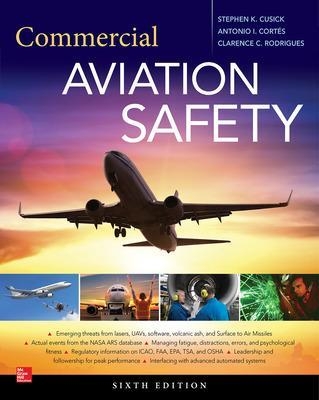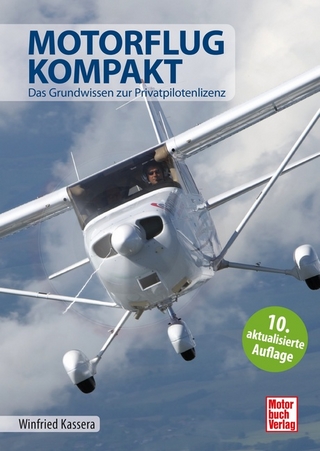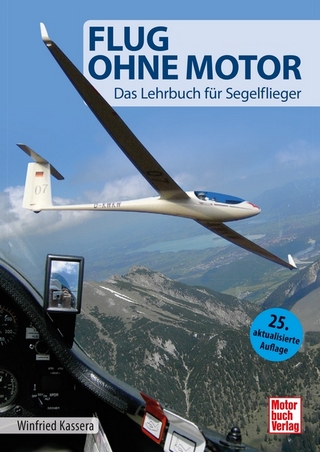
Commercial Aviation Safety, Sixth Edition
McGraw-Hill Education (Verlag)
978-1-259-64182-4 (ISBN)
- Titel ist leider vergriffen;
keine Neuauflage - Artikel merken
Presenting the latest procedures and standards from U.S. and international air traffic and regulatory agencies, this thoroughly revised resource covers the entire commercial aviation safety system—from human factors to accident investigation. National Transportation Safety Board (NTSB), Federal Aviation Administration (FAA), and International Civil Aviation Organization (ICAO) standards are explained in easy-to-understand language.
Re-organized and expanded to reflect current approaches, Commercial Aviation Safety, Sixth Edition, delivers authoritative information on today's security concerns on the ground and in the air. You will learn about changes in systems and regulations, new maintenance and flight technologies, and recent accident statistics. New chapters discuss emerging technologies and human factors in aviation safety, including Crew Resource Management (CRM), situation awareness, and cutting-edge methods to reduce human errors in a highly-automated environment.
• Features examples drawn from real-life accidents and incidents
• Includes new chapters on emerging technologies and flight crew leadership
• Written by a team of aviation experts and dedicated educators
Dr. Rodrigues is currently the Health Safety Environment (HSE) manager for the Petroleum Institute (part of Abu Dhabi National Oil Company - ADNOC) in Abu Dhabi. Prior to his current employment with the Petroleum Institute, he was a tenured, full-professor in the college of aviation and the program chair for the BS in Safety Sciences degree at Embry-Riddle Aeronautical University (ERAU) in Daytona Beach, Florida.
Chapter One. Introduction to Commercial Aviation Safety
Learning Objectives
Introduction
What Is Risk?
Safety Philosophy
Safety Ethics
Safety vs. Security
Tenerife Accident
Aviation Safety History
Significant Aviation Accidents
Measuring Safety
Reactive, Proactive, and Predictive Safety
ASRS Examples
Maintenance
Flight Operations
Air Traffic Control
Ramp Operations
Cabin Crew
Conclusion
Key Terms
Review Questions
Suggested Reading
Web References
Chapter Two. Why Do Accidents Happen?
Learning Objectives
Introduction
Determining the Causes of Accidents
Complex Problems Do Not Have Simple Solutions
Active Causes vs. Root Causes
Case Study: West Caribbean Airways Accident
Case Study: Skid Airways Hypothetical
Using Models to Understand Accident Theory
Reason’s “Swiss Cheese” Model
Shell Model
5-Factor Model
The Element of Luck
Case Study: Air France Flight 4590
Findings and Causes
Recommendations
Investigation
Conclusion
Key Terms
Review Questions
Suggested Reading
Web References
Chapter Three. Humans As the Challenge
Learning Objectives
Introduction
Philosophy of Human Error
Who Is The Ace?
Human Factors
Error Chains
Is “Pilot Error” A Myth?
Cognitive Error
Situational Awareness (SA)
Human Performance
Fitness for Duty
Communication Issues
Humans and Automation
Human Factors Analysis and Classification System (HFACS)
ASRS Examples
Flight Crew Distraction
Flight Crew Fatigue
Flight Crew Incapacitation
Flight Crew Subtle Incapacitation
Maintenance Miscommunication
Air Traffic Control Deviation
Conclusion
Key Terms
Review Questions
Suggested Reading
Web References
Chapter Four. Humans As the Solution
Learning Objectives
Introduction
Professionalism in Aviation
Achieving Peak Individual Performance
Empowered Accountability
Crew Resource Management (CRM)
Evolution of CRM Principles
Central Theme of CRM
Proof of CRM Effectiveness
CRM Pyramid Model
Leadership and Followership for Safety
Ten Key Actions of Capable Safety Leaders
Five Key Actions of Effective Safety Followers
Transcockpit Authority Gradient (TAG)
Communicating for Safety
Coordinating for Safety
Shared Situational Awareness (SSA)
Aeronautical Decision Making (ADM)
The Impact of Culture
Case Study: Jetblue Flight
ASRS Examples
Ramp Operations: Example of Disregard for Authority
Flight Crew: Example of Steep Transcockpit Authority Gradient
Conclusion
Key Terms
Review Questions
Suggested Reading
Web References
Chapter Five. The Role of Government
Learning Objectives
Introduction
International Civil Aviation Organization (ICAO)
Background: The Chicago Convention
ICAO Organization
ICAO Rulemaking
New ICAO Annex 19, Safety Management
ICAO Worldwide Safety Ratings
The Federal Aviation Administration (FAA)
Background
FAA Organization
FAA Safety Inspection Program
FAA Rulemaking
Airworthiness Directives
Example of FAA Rulemaking Process: The ATP-CTP
Recent FAA Regulatory Developments
Occupational Safety and Health Administration (OSHA)
Background
OSHA Organization
OSHA Rulemaking
OSHA Standards Affecting Aviation Operations: Examples
The Environmental Protection Agency (EPA)
Background
EPA Organization and Major Offices
EPA Rulemaking
Major Environmental Laws Affecting Aviation
ASRS Example
Pilot Warns About Fatigue
Conclusion
Key Terms
Review Questions
Suggested Reading
Web References
Chapter Six. Reactive Safety
Learning Objectives
Introduction
Why Investigate?
Findings
Causes
Recommendations
International Accident Investigation
Overview
ICAO’s Role
Regional and National Authorities
Recent Major International Investigation
National Transportation Safety Board
NTSB Mission
NTSB Organization
Office of Aviation Safety
Office of Administrative Law Judges
Accident Investigation Process
Party Process
The Go-Team
Accident Site
Laboratory
Accident Report Preparation
Public Hearing
Final Accident Report Preparation
Safety Recommendations
Investigating a General-Aviation Accident
Family Assistance and the Transportation Disaster Assistance Division
FAA Responsibilities During an Investigation
NTSB Accident Databases and Synopses
NTSB Most Wanted Aviation Safety Improvements
NTSB Most Wanted List for 2017–2018
Case Study: Spanair Flight 5022 Accident
Background
Investigation
Findings
Causes
Recommendations
Conclusion
Key Terms
Review Questions
Suggested Reading
Web References
Chapter Seven. Proactive Aviation Safety
Learning Objectives
Introduction
Flight Operational Quality Assurance (FOQA)
Aviation Safety Action Program (ASAP)
Aviation Safety Reporting System (ASRS)
Line Operations Safety Audit (LOSA)
Advanced Qualification Program (AQP)
Aviation Safety Information Analysis and Sharing (ASIAS)
General Industry (OSHA) Recording and Reporting Systems
Applicability
OSHA Form 300: Log of Work-Related Injuries and Illnesses
OSHA Form 301: Injury and Illness Incident Report
OSHA Form 300A: Summary of Work-Related Injuries and Illnesses
Open Government Initiative (Transparency in Government)
Environmental Recording and Reporting
Other Environmental Reporting Requirements
Control of Air Pollution from Aircraft and Aircraft Engines
Conclusion
Key Terms
Review Questions
Suggested Reading
Web References
Chapter Eight. Aircraft Safety Systems
Learning Objectives
Introduction
Jet Engine Development
Recent Developments in Jet Engine Design
Long-Range Commercial Jet Transport Era
High-Lift Systems
Stopping Systems
Structural Integrity
Cabin Safety
Safety Design for Atmospheric Conditions
Turbulence
Wind Shear
Volcanic Ash
Ice and Precipitation
Flight Deck Human–Machine Interface
Early Flight Deck Development
Flight Deck: Boeing 757/767 and Boeing 747-400
Automation
New Flight Deck Enhancements
Crew Alerting Systems
Aircraft Communications Addressing and Reporting System
Flight Management System
Multiple Flight Control Computers
Central Maintenance Computer System
Modeling, Design, and Testing Tools
Computational Fluid Dynamics (CFD)
Wind-Tunnel Benefits
Flight Simulation
Flight Test
Accident/Incident Investigation
Control Strategies to Manage Threats and Errors
Airbus and Boeing Design Strategies
Flight Deck Standardization
Flight Deck Automation and Precision Navigation
Newer Aircraft Technologies
Weather Detection
Communication and Navigation Systems
Flight Deck Displays
Head-Up Displays (HUDs)
Electronic Flight Bags (EFBs)
Next-Generation Flight Operations
ASRS Examples
Conclusion
Key Terms
Review Questions
Suggested Reading
Web References
Chapter Nine. Designing Airports for Safety
Learning Objectives
Introduction
Airport Certification
Airport Certification Classification
Airport Certification Manual (ACM): FAA AC No. 150/5210-22
Operational Safety
Airport Terminal Buildings
Hangars and Maintenance Shops
Ramp Operations
Specialized Airport Services
Runway Incursions
Airport Surface Environment
Types of Airport Surface Events
Control Strategies and Future Initiatives
Runway Excursions
ASRS Examples
Ramp Surfaces
Pesky Ground Vehicles
Runway Incursion
Case Study: PSA Airlines Flight
Conclusion
Key Terms
Review Questions
Suggested Reading
Web References
Chapter Ten. Air Traffic Safety Systems
Learning Objectives
Introduction
Major Milestones of ATC History
Basic Components of the ATC System
Airspace Classification
ATC Services
Performance-Based Navigation (PBN)
GPS Enhancements
Wide Area Augmentation System
Advantages of Satellite-Based Navigation
Terminal Automation Modernization and Replacement (TAMR)
Update on FAA NextGen Backbone Programs
Airport Surface Detection Equipment, Model X (ASDE-X)
Departures and Arrivals
En Route and Oceanic Operations
Unmanned Aircraft Systems Revolution
Background
FAR Part 107: The Small Uas Rule (Faa Safety Briefing)
Flying Drones Commercially
Impact to Air Traffic Control
ASRS Examples
Air Traffic Control Tower
Air Route Traffic Control Center
Case Study: The 2006 Midair Collision Over Brazil
Conclusion
Key Terms
Review Questions
Suggested Reading
Web References
Chapter Eleven. Safety Data
Learning Objectives
Introduction
Aviation Accident and Safety Statistics
Manufacturers’ Involvement with Safety Data
Boeing’s Accident Statistical Summary
United States’ Statistics
Global Statistics
Occupational Accident Statistics—Department of Labor, Bureau of Labor Statistics (BLS)
North American Industry Classification System (NAICS)
Conclusion
Key Terms
Review Questions
Suggested Reading
Web References
Chapter Twelve. Managing Safety
Learning Objectives
Introduction
Evolution of SMS
ICAO Annex 19: Consolidation of SMS Standards
Structure of SMS: Four Components (Pillars of SMS)
Component #1: Safety Policy
Component #2: Safety Risk Management
Incident and Accident Investigation
Role of Unions
Component #3: Safety Assurance
Safety Performance Indicators
Audits
and Inspections
Component #4: Safety Promotion
Safety Training and Education
Safety Communication
How To Implement SMS: A Phased Approach
Future Challenges
ASRS Examples
Maintenance Procedures and Fuel System Malfunction
Boeing 757 Stall Warning System Fault
Conclusion
Key Terms
Review Questions
Suggested Reading
Web References
Chapter Thirteen. Protection from Intentional Harm (Security)
Learning Objectives
Introduction
Review of Attacks on Civil Aviation
Regulatory Movement
International Response to Terrorism
Evolution of Aviation Security in the United States
Transportation Security Administration
TSA Regulations
Role of Intelligence
National Counterterrorism Center
Department of Homeland Security
Review of Security Technologies
Imaging Technologies
Explosive Trace Detection Technology
Explosive Detection Systems (EDSs)
Metal Detectors
Biometrics and Future Checkpoint Systems
Strengthening Aircraft and Baggage Containers
Cockpit Door Reinforcement
Cybersecurity
ASRS Examples
Security Procedures
Cabin Crew
Conclusion
Key Terms
Review Questions
Suggested Reading
Web References
Chapter Fourteen. The Future of Commercial Aviation Safety
Learning Objectives
Introduction
Air Traffic Management
Airspace Utilization
Unmanned Aircraft Systems (UAS)
Commercial Space Vehicles
Oceanic Tracking
Surface to Air Missiles
Aircraft Design
Aircraft Icing Prevention
Software Safety and Cybersecurity
Human Performance and Reliability
Lasers
Psychological Fitness for Duty
Safety Management Systems
SMS Variable Interdependencies
Fusing Proactive Data Streams
Training New Accident Investigators
Enhancing the Depth of Academic Education
Artificial Intelligence
Recent Advances
Situational Scenario
Conclusion
Key Terms
Review Questions
Suggested Reading
Web References
Index
| Erscheinungsdatum | 02.06.2017 |
|---|---|
| Zusatzinfo | 75 Illustrations |
| Verlagsort | OH |
| Sprache | englisch |
| Maße | 191 x 226 mm |
| Gewicht | 1125 g |
| Themenwelt | Natur / Technik ► Fahrzeuge / Flugzeuge / Schiffe ► Luftfahrt / Raumfahrt |
| Sozialwissenschaften ► Soziologie | |
| Technik ► Fahrzeugbau / Schiffbau | |
| Technik ► Luft- / Raumfahrttechnik | |
| ISBN-10 | 1-259-64182-1 / 1259641821 |
| ISBN-13 | 978-1-259-64182-4 / 9781259641824 |
| Zustand | Neuware |
| Informationen gemäß Produktsicherheitsverordnung (GPSR) | |
| Haben Sie eine Frage zum Produkt? |
aus dem Bereich


